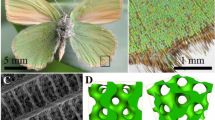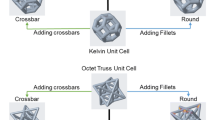Abstract
Lattice structures have proven to have excellent mechanical properties in several loading conditions for a wide range of applications and additive manufacturing enables to fabricate these intricate as well as complex structures with exceptional accuracy. However, studies of mechanical properties of these structures in response to torsional and other complex loading are very limited. In this study, three different structures namely gyroid, primitive, and vertical-inclined were designed in cylindrical shape samples and additively manufactured using MultiJet fusion technology. Torsion tests until failure of structures were performed to study mechanical properties including torsional stiffness, energy absorption, and failure modes of structures. In addition, a new method of calculating polar moment of inertia is established taking the non-uniform cross section of the structures into account for accurate calculation of torsional properties. Experimental results indicate that the surface-based gyroid and primitive structures have superior torsional stiffness, energy absorption capacity, and ultimate strength compared to the strut-based vertical-inclined structure. Gyroid structure has almost 9% higher torsional stiffness value than primitive structure and nearly two times higher stiffness than vertical-inclined structure. However, primitive structure showed superior energy absorption capacity of 8 J/mm3 withstanding a large amount of plastic deformation. In contrast, both gyroid and vertical-inclined structures had lower energy absorption capacity values of 3.72 J/mm3 and 2.27 J/mm3, respectively. Lastly, failure mode of structures revealed that both gyroid and vertical-inclined failed in a brittle manner with fractures at an angle to their longitudinal axis while primitive structure showed ductile mode of failure with fracture perpendicular to its longitudinal axis.















Similar content being viewed by others
Data Availability
Data are available on request from the authors.
References
Reeves P, Tuck C, Hague R (2011) Additive Manufacturing for Mass Customization. Springer, London, pp 275–289
(2021) Complex geometries are possible with 3D printing | EOS. https://www.eos.info/en/industrial-3d-printing/advantages/complex-geometries. Accessed 3 Jul 2021
Romero L, Jimenez M, Dominguez IA et al (2019) Additive Manufacturing Technologies: An Overview about 3D Printing Methods and Future Prospects. Complexity. https://doi.org/10.1155/2019/9656938
Nazir A Jeng JY (2020) A high-speed additive manufacturing approach for achieving high printing speed and accuracy. Proc Inst Mech Eng Part C J Mech Eng Sci 234:2741–2749. https://doi.org/10.1177/0954406219861664
Parandoush P, Lin D (2017) A review on additive manufacturing of polymer-fiber composites. Compos Struct 182:36–53
Guo N, Leu MC (2013) Additive manufacturing: Technology, applications and research needs. Front Mech Eng 8:215–243
Manoharan V, Chou SM, Forrester S et al (2013) Application of additive manufacturing techniques in sports footwear. Virtual Phys Prototyp 8:249–252. https://doi.org/10.1080/17452759.2013.862958
Seabra M, Azevedo J, Araújo A et al (2016) Selective laser melting (SLM) and topology optimization for lighter aerospace componentes. In: Procedia Structural Integrity. Elsevier B.V., pp 289–296
Boschetto A, Bottini L, Cardini V et al (2021) Aircraft part substitution via additive manufacturing: design, simulation, fabrication and testing. Rapid Prototyp J ahead-of-print: https://doi.org/10.1108/RPJ-06-2020-0140
van Woensel R, vanOirschot T, Burgmans MJH et al (2018) Printing Architecture: An Overview of Existing and Promising Additive Manufacturing Methods and Their Application in the Building Industry. Int J Constr Environ 9:57–81. https://doi.org/10.18848/2154-8587/cgp/v09i01/57-81
Javaid M, Haleem A (2019) Current status and applications of additive manufacturing in dentistry: A literature-based review. J Oral Biol Craniofacial Res 9:179–185
Gorji NE, Motas JG, Nedelcu D (2021) XPS, SEM, DSC and Nanoindentation Characterization of Silver Nanoparticle-Coated Biopolymer Pellets. Appl Sci. 11:7706. https://doi.org/10.3390/APP11167706
Yuan L, Ding S, Wen C (2019) Additive manufacturing technology for porous metal implant applications and triple minimal surface structures: A review. Bioact Mater 4:56–70
Han L Che S (2018) An Overview of Materials with Triply Periodic Minimal Surfaces and Related Geometry: From Biological Structures to Self-Assembled Systems. Adv Mater 30:1705708
TripathiY, ShuklaM (2017) Triply periodic minimal surface based geometry design of bio-scaffolds. In: 2017 International Conference on Advances in Mechanical, Industrial, Automation and Management Systems, AMIAMS 2017 - Proceedings. Institute of Electrical and Electronics Engineers Inc pp 348–350
Zhang L, Feih S, Daynes S et al (2018) Energy absorption characteristics of metallic triply periodic minimal surface sheet structures under compressive loading. Addit Manuf 23:505–515. https://doi.org/10.1016/j.addma.2018.08.007
Nazir A, Abate KM, Kumar A Jeng JY (2019) A state-of-the-art review on types, design, optimization, and additive manufacturing of cellular structures. Int J Adv Manuf Technol 104:3489–3510. https://doi.org/10.1007/s00170-019-04085-3
Jared BH, Aguilo MA, BeghiniLL et al (2017) Additive manufacturing: Toward holistic design. Scr Mater 135:141–147. https://doi.org/10.1016/j.scriptamat.2017.02.029
Wang L, Lau J, Thomas EL, Boyce MC (2011) Co-continuous composite materials for stiffness, strength, and energy dissipation. Adv Mater 23:1524–1529. https://doi.org/10.1002/adma.201003956
Liu F, Zhao M, Fu G et al (2018) Improved mechanical properties and energy absorption of BCC lattice structures with triply periodic minimal surfaces fabricated by SLM Materials (Basel) 11. https://doi.org/10.3390/ma11122411
Abueidda DW, Elhebeary M, Shiang CSA, Pang S, Al-Rub RKA, Jasiuk IM (2019) Mechanical properties of 3D printed polymeric Gyroid cellular structures: experimental and finite element study. Mater Des 165:107597. https://doi.org/10.1016/j.matdes.2019.107597
Sychov MM, Lebedev LA, Dyachenko SV, Nefedova LA (2018) Mechanical properties of energy-absorbing structures with triply periodic minimal surface topology. Acta Astronaut 150:81–84. https://doi.org/10.1016/j.actaastro.2017.12.034
Yu S, Sun J, Bai J (2019) Investigation of functionally graded TPMS structures fabricated by additive manufacturing. Mater Des 182:108021. https://doi.org/10.1016/j.matdes.2019.108021
Kladovasilakis N, Tsongas K, Tzetzis D (2021) Mechanical and FEA-Assisted Characterization of Fused Filament Fabricated Triply Periodic Minimal Surface Structures. J Compos Sci 5:58. https://doi.org/10.3390/jcs5020058
Mittag U Kriechbaumer A, Rittweger J (2018) Torsion-an underestimated form shaping entity in bone adaptation? J Musculoskelet Neuronal Interact 18:407–418
Boccini E, Furferi R, GoverniL et al (2019) Toward the integration of lattice structure-based topology optimization and additive manufacturing for the design of turbomachinery components. Adv Mech Eng 11:1–14. https://doi.org/10.1177/1687814019859789
Concli F, Gilioli A (2019) Numerical and experimental assessment of the mechanical properties of 3D printed 18-Ni300 steel trabecular structures produced by Selective Laser Melting–a lean design approach. Virtual Phys Prototyp 14:267–276. https://doi.org/10.1080/17452759.2019.1565596
Sharma R (2019) An Investigation into the Stiffness Response of Lattice Shapes under Various Loading Conditions
Topology N(2021) Next Generation Design Engineering Software. In: nTopology. https://ntopology.com/. Accessed 1 Jun 2021
(2002) Standard Test Method for Shear Modulus at Room Temperature. In: ASTM Book of Standards
Hewlett-Packard (2021) HP 3D Jet Fusion 5200 - Commercial & Industrial 3D Printer | HP® Official Site. https://www.hp.com/us-en/printers/3d-printers/products/multi-jet-fusion-4200.html. Accessed 22 Jun 2021
(2021) HP3D Technical White Paper. https://reinvent.hp.com/us-en-3dprint-wp-technical. Accessed 22 Jun 2021
(2021) Handbook. https://reinvent.hp.com/us-en-3dprint-mjfhandbook. Accessed 22 Jun 2021
(2021) SOLIDWORKS. https://www.solidworks.com/. Accessed 22Jun 2021
Nazir A, Arshad AB, Jeng J-Y (2019) Buckling and Post-Buckling Behavior of Uniform and Variable-Density Lattice Columns Fabricated Using Additive Manufacturing. Materials (Basel) 12:3539. https://doi.org/10.3390/ma12213539
(2021) Ansys | Engineering Simulation Software. https://www.ansys.com/. Accessed 10 Jul 2021
Walsh AM (2017) Lecture Notes. Anesth Analg 124:1361. https://doi.org/10.1213/ane.0000000000001871
Xiao Y (2012) Basic Mechanical Tests. https://www.scribd.com/document/96138680/Basic-Mechanical-Tests. Accessed 22 Jun 2021
Funding
This work was financially supported by the High-Speed 3D Printing Research Center (Grant No. 108P012) from the Featured Areas Research Center Program within the framework of the Higher Education Sprout Project by the Minister of Education (MOE) Taiwan.
Author information
Authors and Affiliations
Corresponding authors
Ethics declarations
Ethics approval
Not Applicable
Consent for publication
Not Applicable
Consent to participate
Not Applicable
Conflict of interest
The authors have no conflict of interest to declare.
Additional information
Publisher's Note
Springer Nature remains neutral with regard to jurisdictional claims in published maps and institutional affiliations.
Rights and permissions
About this article
Cite this article
Hailu, Y.M., Nazir, A., Hsu, CP. et al. Investigation of torsional properties of surface- and strut-based lattice structures manufactured using multiJet fusion technology. Int J Adv Manuf Technol 119, 5929–5945 (2022). https://doi.org/10.1007/s00170-022-08681-8
Received:
Accepted:
Published:
Issue Date:
DOI: https://doi.org/10.1007/s00170-022-08681-8




